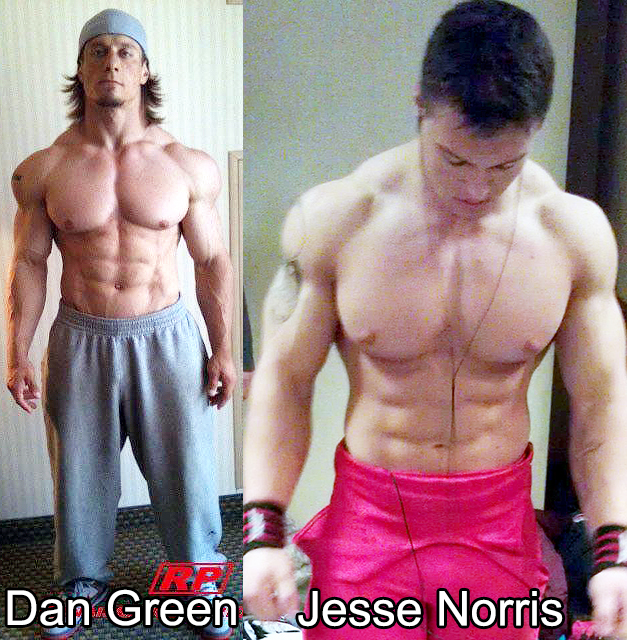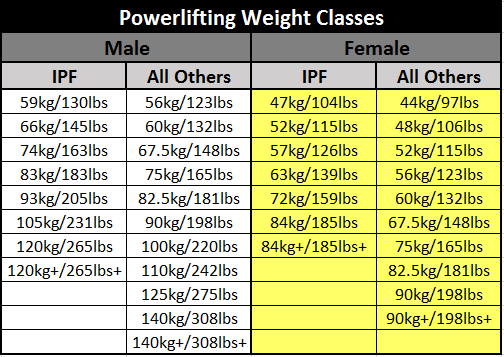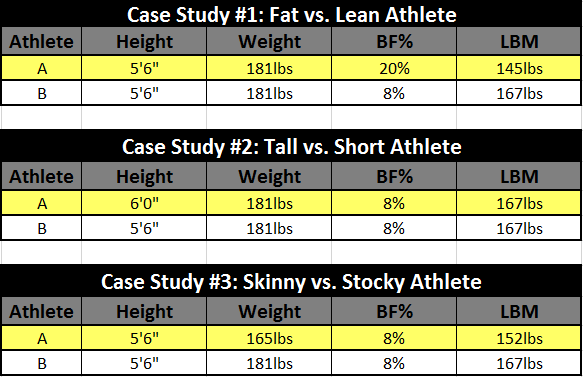So begins the PowerliftingToWin Nutrition Series!
Nutrition, in powerlifting, primarily serves two purposes: 1) performance enhancement and 2) weight management. When done properly, both of these ends are met simultaneously. That is, you do not need to choose between being strong and fat or weak and lean.
There is no “or” here. When nutrition is dialed in, you are both strong AND lean. That is the purpose of powerlifting nutrition in a nut shell – at least here on PowerliftingToWin. Our entire goal in this nutrition series is to lay down an EXACT plan, step-by-step, for how one can maintain a lean physique year round while simultaneously adding muscle and strength. To be explicitly clear, just as in the programming series, when the nutrition series wraps up, I will be releasing a free eBook detailing the exact nutrition plan and weight management strategy that I believe to be optimal.
Sound good? Good. Let’s talk about weight classes.
If you’d rather watch than read:
Powerlifting Weight Classes
For those who don’t know, Powerlifting is a weight class sport. A weight class sport is one in which competitors are divided up into different divisions depending on how much they weigh. You cannot compete in any class where you are above the maximum weight and, likewise, you cannot compete in any class where you do not make the minimum weight. Whatever weight class you fall “inside of”, is the weight class where you must compete.
Weight classes ensure that everyone has a fair shot to win if they play their cards right. You cannot use height as an excuse.
How to Pick Your Weight Class
Now, this obviously leads one to ask, “Well, how should I go about determining the weight class that is best for me”? Good question.
I think the idea that one “chooses” their weight class is misleading if not outright false. The weight class that one should compete in is the weight class where the amount of muscle on their frame is maximized relative to the limit of that weight class. Put simply, you want to carry as much muscle as is possible while still making weight. For the sharp among you, yes, that means you need to be relatively lean in order to maximize and optimize your competitiveness in powerlifting.
Being Fat Does NOT Improve Leverages!
Why? Because fat doesn’t contract. People constantly talk about how fat improves your “leverages”. For the most part, it actually doesn’t. First of all, unlike muscle, fat is highly compressible and thus adds little in terms of actual leverage at the joints themselves.
For the truly obese, fat can help in the squat and bench press because it can somewhat reduce range of motion. In the squat, a big, fat gut can provide a cushion in the bottom when your belly compresses into your thighs. However, unless you are a geared powerlifter, meaning someone who uses squat suits and bench shirts, being fat is not going to appreciably increase performance.
The Real Reason Being Fat Helps You Lift More
That said, when you’re “bigger”, you’ll often notice that you can lift more. In my opinion, this is primarily due to the fact that you’re in an overfed state for a prolonged period of time.
Remember that whole spheal about nutrition being performance enhancing? Well, water, unlike fat, DOES add to leverage. And what is the primary determinant of how much water a natural powerlifter carries? That answer is the current state of their glycogen levels. Glycogen levels are determined by your carbohydrate intake. When you’re constantly eating enough to gain weight, assuming you’re not doing some sort of low carb non-sense, your glycogen tank is completely full.
Not only does this mean you’re carrying more water which DOES improve leverage, but you also go into each workout in a more recovered state and with more overall energy in your tank (because glycogen levels are full). Over time, this is going to lead to increased performance both via the synthesis of new muscle tissue and simply due to the fact that eating more, in general, is better for performance. The being fat part has little to do with it.
Powerlifting Body Composition Case Studies
Let’s take a look at three case studies to crystallize the concept of why you need to maximize your muscle mass relative to your weight class.
Case Study 1: Fat Athlete vs. Lean Athlete
Height, Weight, Body Fat %
Athlete A: 5’6”, 181lbs, 20% Body Fat
Athlete B: 5’6”, 181lbs, 8% Body Fat
Between these two athletes, who do you think is going to win? If you’re not dense, you realize that Athlete B wins every time. Let’s do some quick math to see why. Using the body fat figures, we can calculate “lean body mass” (LBM) which is the amount of fat-free mass someone carries. Athlete B is carrying 166.5lbs of LBM while Athlete B carries 145lbs. Because they’re the same height, we can assume their bones, blood, etc. weigh a relatively similar amount. This means Athlete B is carrying perhaps 20lbs more of pure muscle. Muscle contracts; muscle is the power that lifts weight. Is it really any wonder that Athlete B is going to dominate Athlete A?
This is why you need to be relatively lean regardless of what weight class you compete in. Being lean means you’re carrying more muscle mass relative to the class weight limit.
Case Study 2: Skinny Athlete vs. Stocky Athlete
Athlete A: 6’0”, 181lbs, 8% Body Fat
Athlete B: 5’6”, 181lbs, 8% Body Fat
Between these two athletes, who do you think is going to win? Now, for some of you, this might be a bit more of a tricky question. If you do the math, it should be obvious that both athletes have the exact same amount of LBM. However, we can still reliably predict that Athlete B is the likely winner here. Why? Because more of Athlete A’s LBM comes from his skeleton, blood, organs, etc. More of Athlete B’s LBM is coming from pure muscle mass simply because his skeleton weighs less.
This is why being lean is not enough to be competitive. You need to carry as much muscle as possible. Otherwise, you’ll be competing against shorter athletes who can fit more muscle onto their frame while still staying in that weight class.
Case Study 3: Lighter Athlete vs. Bigger Athlete
Athlete A: 5’6”, 165lbs, 8% Body Fat
Athlete B: 5’6”, 181lbs, 8% Body Fat
Between these two athletes, who do you think is going to be more competitive as a powerlifter? Of course, these guys won’t be competing against each other; they’re not in the same weight class. However, who do you think has a better chance of placing first in their respective division? The answer is, again, Athlete B. Why? Because Athlete B has more muscle as a percentage of his weight class than does Athlete A. It is more likely that Athlete B will have the most muscle in his weight class than it is that Athlete A will be the most muscular lifter in his weight class.
While muscle isn’t the sole determinant of lifting ability, it is one of the single biggest factors. You must maximize the amount of muscle you carry relative to the weight class you’re competing in. Otherwise, again, even if you’re very lean, you’ll lose to shorter competitors.
With time, and I must emphasize WITH TIME, while still being lean, you should aim to be the shortest and most muscular person in your weight class.
Conclusions about Powerlifting Nutrition
Given that we’ve established the primary goals of powerlifting nutrition are both to manage our weight and enhance our performance; given that that we now know optimal weight management entails staying relatively lean so that we can maximize the amount of muscle we carry relative to the class we compete in; and, given that we now know that performance is enhanced by consuming large amounts of energy substrates and staying in an overfed state (surplus) for a prolonged period of time, we can come to several conclusions about the goals of our powerlifting nutrition plan:
1) We want to gain as much muscle as possible
2) We want to stay at a “competitive” body fat percentage
3) We want to spend as much of the year as is possible in a caloric surplus
Now that we’ve covered the “what” of Powerlifting Nutrition, in the next article we’re going to discuss the “how” from a broad perspective; we’re going to talk about how to “manage your weight” from the 30,000 foot view.
In subsequent articles, we’ll break down each piece of the process getting into the exact details of cutting, bulking, and making weight. With time, we’ll bring the full EatingToWin strategy to life.
Did you enjoy the Powerlifting Nutrition Series?
If so, I highly recommend you check out our eBook: EatingToWin. The book contains absolutely everything you need to know about how to set up the optimal diet for YOU personally as a powerlifter, how to identify the right weight class to maximize your competitiveness, how to cut weight like a PRO so that you can drop a weight class without performance loss, and, of course, an entire section on recommended supplements with the supporting evidence behind each recommend. Grab your copy now!
Like this Article? Subscribe to our Newsletter!
If you liked this articled, and you want instant updates whenever we put out new content, including exclusive subscriber articles and videos, sign up to our Newsletter!
Questions? Comments?
For all business and personal coaching services related inqueries, please contact me:
[contact-form-7 id=”3245″ title=”Contact form 1″]
Table of Contents
Powerlifting Nutrition: How To Pick Your Weight Class
Powerlifting Diet: Cutting and Bulking
The Best Way To Measure Body Fat For Powerlifting
When To Move Up A Weight Class
How To Cut Weight For Powerlifting: 24 Hour and 2 Hour Weigh Ins
How To Diet For Powerlifting: Calories, Reverse Dieting, and More
Setting Up Your Powerlifting Macros
Meal Frequency and Nutrient Timing in Powerlifting
Eating Healthy for Powerlifting
Best Powerlifting Supplements




Looking forward to the rest of the series!